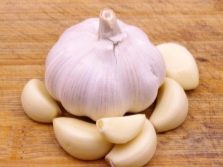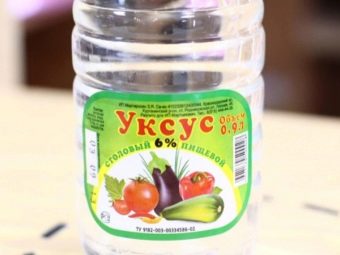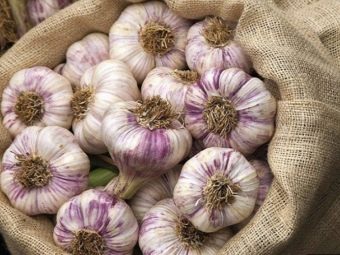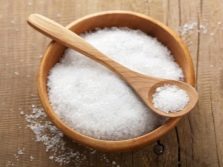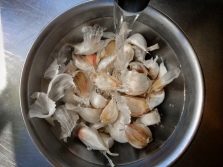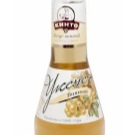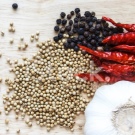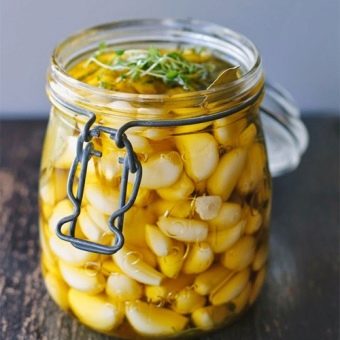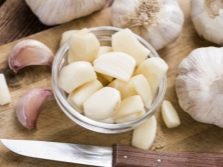How to cook pickled garlic?
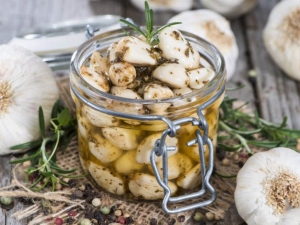
Garlic (Allium sativum) is a culture highly valued throughout the world. Egyptian medical papyrus, dating back to about 1550 BC, mentions garlic as an effective treatment for various diseases.Ancient physicians, such as Hippocrates, Pliny, and Aristotle, used this plant for therapeutic purposes. Today it is widely used as a seasoning or spice. Most of the garlic used in the world comes from China, South Korea, India, Spain and the United States.
In this article we will look at how you can pickle garlic and get a healthy, beautiful dish in taste.
Benefit
Garlic can rightly be called one of the most wonderful plants with healing power. It can suppress and kill bacteria, fungus, lower blood pressure, cholesterol and blood sugar. Prevents blood clotting and contains antitumor substances. It can also stimulate the immune and lymphatic systems.
It is considered an effective antioxidant and protects cells from free radical damage.
This can help prevent some forms of cancer, heart disease, strokes and viral infections. Garlic contains more than two hundred chemicals that have the ability to protect the human body from a wide range of diseases. Sulfur compounds found in garlic provide for the production of certain beneficial enzymes.
Cardiovascular diseases
Violations of the cardiovascular system take more lives than any other disease. The most common are high blood pressure and high serum cholesterol. Studies conducted on rabbits with coronary heart disease have found that atherosclerotic deposits can virtually disappear with regular consumption of garlic. It also lowers high blood pressure. A garlic tablet containing 31.2 mg of allicin reduces the diastolic pressure by 16 mm Hg.
Platelets and fibrin play a significant role in blood coagulation. A large amount of fibrin in the blood can cause a heart attack. Garlic components can reduce the formation of a given substance. It is believed that adding garlic to the diet can increase the breakdown of fibrin from 24 to 30%.
Weak immunity
With the advent of frightening viral diseases such as AIDS and hepatitis C, the immune system is gaining more and more attention. Since these types of diseases are not amenable to effective treatment, strengthening the ability to fight infection has become even more important. Garlic contains a rich sulfur-containing amino group of acids and other compounds, which, apparently, initiate increased activity in the immune system.
We are constantly under the influence of malnutrition, cigarette smoke, mental stress and chemical pollution. Thus, tremendous pressure is put on our immune system, and additional substances contained in garlic are needed to maintain it: germanium, thiamine, sulfur, niacin, phosphorus and selenium.
Diabetes
A number of animal studies confirm the effectiveness of garlic in reducing blood glucose levels.
Oncological diseases
The anti-cancer properties of garlic are perhaps the best known. Numerous epidemiological, clinical and laboratory studies have shown that it plays a large role in the prevention of cancer, especially the digestive tract. Regular consumption of garlic reduces the risk of cancer of the esophagus, stomach and colon.
This is due to the antioxidant effect of allicin, which reduces the formation of carcinogenic compounds in the gastrointestinal tract.
Antimicrobial action
The antimicrobial properties of this plant were first described by Pasteur (1958), and since then many studies have confirmed its effectiveness and a wide range of activity against many types of bacteria, viruses, parasites and fungi. Garlic is more effective than commercial antibiotics and has fewer side effects, so it is used as an alternative treatment for various infections.Garlic and its components have confirmed activity against herpes simplex virus type 1 and 2, influenza B, immunodeficiency virus and rhinovirus.
Antibacterial properties
Garlic extract inhibits the growth of bacteria such as staphylococcus, streptococcus, shigella, salmonella and helicobacter. The active compounds in garlic play a large role as a local antifungal agent. Garlic oil can be used to treat ringworm, skin parasites and warts.
Antihelminthic qualities
Many herbalists around the world recommend garlic as a cure for intestinal parasites. In some cultures, children infected with worms are treated with enemas containing minced garlic. One of the traditional Chinese methods of treating intestinal diseases is an alcoholic extract of crushed garlic cloves.
Harm
The main side effect commonly associated with garlic is mouth odor, especially when using a raw product. Nausea and vomiting are possible when drinking large amounts. Garlic juice can act as a strong emetic even in small quantities. There are isolated cases of burns and allergic shocks. It is also usually cautioned against the use of garlic when using anticoagulant therapy.
Very carefully you need to eat garlic for people who are obese. The product itself, of course, contains few calories, but it incredibly stimulates the appetite. For many, the smell of garlic immediately causes the desire to eat tightly, and, mainly, fatty, high-calorie foods.
Do not get involved in garlic and those who have diseases of the stomach and intestines. This refers to the period of their aggravation. The product will irritate the mucous membranes, causing indigestion and nausea.
Garlic is absolutely contraindicated in hemorrhoids, epilepsy and pregnancy.
Recipes
Marinated garlic is good both in salad sauces, and in itself. It is especially tasty if you add some fruit oil to it. Marinated cloves can be cut and added to roasted vegetables, it will give the finished dish flavor and pleasant sourness. When the jar of pickled garlic is almost over, the remaining pickle can be consumed in mashed beans or potatoes, in salads.
The use of pickled garlic does not give the negative effects associated with the smell. This is because acetic acid neutralizes allicin and contributes to its transformation into odorless water-soluble compounds. These compounds, circulating through the bloodstream, reduce cholesterol, blood pressure and sugar. It is remarkable that the longer the garlic remains in vinegar, the more such healthy compounds are formed.
Garlic can be marinated at home in various ways.
In Chinese
Ingredients:
- 400 to 500g fresh garlic;
- white rice vinegar / rice wine vinegar;
- 1 teaspoon salt;
- 2 tablespoons of sugar.
Separate the heads into the teeth, scald and clean. Place the vinegar, salt and sugar in a saucepan, stir and bring to a boil. Add the garlic cloves and bring to the boil again, stirring. Pack in a hot, sterilized jar. Refrigerate and refrigerate. Use in a month.
In Korean
In Korea, garlic cloves are first soaked in acetic brine for several days, and then marinated in soybean brine. Passing through this two-step process, garlic loses most of its pungent taste and becomes slightly sweet. It is important to use fresh garlic for cooking. Serve it with rice or accompanied by any main course. The remaining marinade can be used as a sauce or seasoning.
Ingredients:
- 8-9 whole heads of garlic.
For vinegar brine:
- 2/3 cup vinegar;
- 1 tablespoon salt;
- 1 and 1/3 cup of water.
For soy pickle:
- 2/3 cups of soy sauce;
- 1/4 cup vinegar;
- 3 tablespoons of sugar;
- 1 and 1/3 cup of water.
Separate the heads into cloves and soak in hot water for 30 minutes or longer. Soaking helps to clean the teeth easily. After cleaning, remove the ends of the roots with a small knife, rinse and place in a jar.
Mix the ingredients in the brine vinegar until the salt is dissolved. Fill the garlic cloves. The liquid must completely cover them.
Let stand at room temperature for 5-7 days.
Bring the ingredients to a boil and add the boil for 5 minutes over medium heat. Allow to cool completely. Drain the vinegar pickle from the jar and pour cold soy pickle instead. Make sure all the cloves are completely covered with brine.
Close the jar tightly with the lid and let stand at room temperature for 2 weeks. After that, you can eat garlic, but it will be better when it lasts longer.
With honey
Like garlic, honey has a long history as a remedy. It was used in ancient Egypt to heal wounds, in ancient Greece - to prolong life, and is even referred to as a medical tool in the Quran!
Honey is an antibiotic with antiviral, antiseptic, anti-toxic, anti-inflammatory and antifungal properties. It is rich in vitamins, minerals and enzymes that enhance our immunity, which is especially important in the fight against disease. Honey glucose is instantly absorbed, providing a quicker supply of energy, while honey fructose is absorbed more slowly, providing more sustainable energy.
The unique property of honey is that it consists of 80% sugar and 20% water, which makes it stable. Garlic juice increases the moisture content of honey, but only until the moment when fermentation begins. Garlic marinated in honey will be soft and much more pleasant. Honey, in turn, will take on some of the garlic taste and darken. A mixture of honey, garlic and vinegar not only relieves cold symptoms, but also treats common diseases such as dyspepsia, heartburn and headaches.
Honey for this recipe should be fresh. It is better to use honey from local beekeepers. Optionally, you can add to the recipe some kinds of spices (for example, bay leaf or thyme).
Ingredients:
- garlic cloves (amount optional);
- Apple vinegar;
- honey.
Fill one-liter jar with peeled slices, cover with apple cider vinegar and keep at room temperature for four weeks. After this, drain the apple cider vinegar. Half of the resulting liquid is placed in a saucepan, add a glass of honey. Heat and stir until honey and vinegar are completely mixed. Fill the lobules with this mixture and place in a cool dark place for another four weeks. After that, you can use garlic for cooking as a side dish or just eat it, because it is very tasty.
This medicinal pickled garlic can be stored for almost a year.
In persian
When raw garlic cloves are immersed in plain white vinegar for a very long time, they are magically transformed. Crunchy white slices become ivory-colored, sometimes tinged with blue-green, and eventually become light brown in color, which deepens with age. After a few years, garlic acquires a very delicate, almost fruity taste, and the pickle has a deep mahogany color, reminiscent of balsamic vinegar.
Such garlic mainly serves as an independent snack of the type of olives, and is rarely added to other dishes. Considering the long time of exposure and the healing and taste qualities acquired at the same time, this pickled garlic is considered a real delicacy.
Method one
Ingredients:
- 4-6 heads of garlic;
- 1 cup distilled white vinegar;
- 1 tablespoon salt;
- 1 tablespoon honey.
Divide the garlic heads into separate slices, but do not peel them, otherwise as they age and soften, they will turn into a mash.Try to pick up slices of the same size and carefully pack them in a pre-sterilized jar.
Add honey and salt to vinegar and mix until dissolved. Then fill the jar with the mixture, leaving about 2 cm of free space. You may need to put a load on top.
Put the lid on the jar, but do not seal it too much. The gas generated during fermentation should have an outlet, so during the first week the lid will have to be opened about two times a day.
After the fermentation is complete, the garlic should soften and no longer float. You can remove the load, add vinegar to the jar and close it again. Store the product in a cool, dark place for at least a year, but perfect taste is obtained only after seven years of aging.
Second way
Ingredients:
- 4-6 heads of garlic;
- 2 cups distilled white vinegar;
- 1 tablespoon salt;
- 1 tablespoon honey;
- 3 tablespoons balsamic vinegar.
Divide the garlic heads into separate slices, but do not peel them. Bring garlic and white vinegar to a boil, add salt and honey and simmer for another 5 minutes. The garlic cloves will soften a bit, but should still remain firm enough if their peel is intact.
Pack the slices into a pre-sterilized jar, add 3 tablespoons of balsamic vinegar, and then fill the jar with cooled white vinegar, leaving about 2 cm of free space.
Unlike the traditional method, this garlic should not ferment.
In addition, since this garlic is pre-stewed, it is immersed in a pickle and does not need additional weight. The jar can be immediately sealed and stored in a cool, dark place for 3 months or up to 1 year.
Georgian
Georgia is the garlic capital of the planet. More than 150 known varieties of garlic grow in Georgia. This is almost 1/3 of all known species on Earth! Georgians pickle garlic in a unique brine made from pomegranate juice, vinegar and black pepper. Coriander seeds and fresh basil are classic Georgian seasonings; they add their flavor to the marinade. This is a great way to save garlic for the winter when you have a lot of it. If you pour olive oil, it can be served whole as a snack.
Ingredients:
- 2 large heads of garlic (remove the outer shell, but do not clear until the end);
- 1 tablespoon salt;
- 2 teaspoons of sugar;
- ½ cup unsweetened pomegranate juice;
- ? cups of white wine vinegar;
- 1 tablespoon of black pepper peas, chopped or lightly chopped;
- 3 dried red chili peppers, sliced or torn by hand;
- 1 tablespoon of fresh dill;
- 2 fresh basil leaves;
- 1 tablespoon of coriander seeds, crushed or slightly crushed.
Place the garlic in a sterile jar and add salt. Heat the pomegranate juice and vinegar in a small saucepan to bring to the boil. Add black pepper, chili pepper, basil, coriander seeds and dill to the jar, then pour the mixture of pomegranate juice and vinegar on top. Cover the jar and shake well. Make sure that the garlic remains immersed in the solution - if necessary, cover the contents of the can with the washed cabbage leaf from above.
Store in the refrigerator for at least 1 month. Shake the jars at least 2-3 times a week while they ripen to ensure that the marinating process takes place evenly. By the way, the remaining pickle is a wonderful seasoning for almost all dishes!
In olive oil
This delicious fast food is cooked in less than 10 minutes. Garlic is soaked with olive oil, and as a result, it loses its sharp spicy taste and becomes creamy, while herbs and olive oil are soaked with garlic. This is one of the best additions to soups, stews and roasts.
Ingredients:
- 5 cleaned heads of young garlic
For a cup of marinade:
- 6-8 fresh thyme stalks;
- 2 bay leaves;
- about 1 cup of olive oil.
Bring the marinade to a boil in a small saucepan over medium heat.
Add garlic cloves to boiling liquid and cook for 30-45 seconds. Do this in two batches if necessary. Remove the slices from the marinade and let them dry on several layers of paper towels.
Spread the slices in two sealed cans. Place 3-4 stalks of thyme and one bay leaf between the lobules in each jar. Add enough olive oil to cover the cloves and herbs. Seal the jars and place them in the refrigerator. Garlic is ready to use in 48 hours. You can store up to 3 months.
Fermented garlic
A simple way to improve the natural antiviral power of garlic is to cook a fermented product. It eliminates the negative aspects of eating raw garlic without reducing or eliminating any natural benefits. In addition, the probiotic and enzymatic value of garlic is enhanced by fermentation.
Fermented garlic is a natural remedy for sore throat. To get rid of it, just suck lobule. While sucking raw garlic (not to mention chewing it) is a difficult task for many people, sucking on fermented garlic is pretty easy and even pleasant. The fermentation process usually eliminates all the unpleasant aspects associated with smell and spicy taste. Thus, fermented garlic cloves are a great option for children and for those who are sensitive to raw garlic.
Ingredients:
- 5-6 heads of garlic, preferably organic;
- 0.5 l of filtered water;
- 1 tablespoon of sea salt.
Separate the teeth from the heads, carefully remove the peel from each clove. Place all the specimens in a jar and fill it with filtered water mixed with sea salt. Place a load on top. This will help keep the teeth in the bottom of the jar. Make sure that at least 2-3 centimeters of air filled with air remains at the top of the jar.
Close the lid tightly and place the jar in a cool place for a month. It is best to stick a label on it so that you remember when the fermentation began. You can check the status of the cans every week for a month. If the water level has dropped, add a solution of sea salt.
A month later, move the jar in the refrigerator.
Use fermented garlic cloves as needed, as one of the best natural antibiotics, and also as a seasoning. Open the jar above the sink, as the fermentation process can significantly increase the pressure under the lid. If you get sick during the time garlic is still fermented, you can still use it for treatment. The therapeutic effect, one way or another, will come.
Tips
To cook garlic correctly and without problems, The following tips are recommended.
- For successful pickling, it is preferable to use organically grown garlic, which does not contain pesticides or harmful chemicals.
- For blanks, choose tight and heavy heads. Do not take the heads in which the cloves begin to move away from the center.
- To quickly clean the cloves, try blanching them. Blanching is a process in which products are immersed in boiling water (in this case, teeth should be boiled for 2 minutes). After blanching, hold the teeth under cold running water for a couple of minutes. Now pinch the clove between your thumb and forefinger and push it towards the opposite end, thereby clearing it. Spread the cleaned cloves on a clean kitchen towel and let dry for 10 minutes.
- If you clean the cloves with salt and leave in a dry cool place for 24 hours and then drain the accumulated liquid, they will become crispy and remain so after pickling.
- A well-sterilized environment and personal hygiene are also important for the marinating process.Be sure to wash your hands, wear clean new gloves and carefully sterilize all items for canning and dishes in boiling water. For best results, use antimicrobial herbs and spices, such as mustard seeds, cinnamon or cloves. They are usually added to vinegar or pickle before storage.
- Sometimes pickled garlic (especially fermented) turns blue or turquoise. This is completely normal and safe, and you don’t need to worry about making any mistakes during sterilization. Garlic contains beneficial sulfur compounds that can react with copper in water to form copper sulfate. It is a blue or blue-green substance. The amount of copper needed for this reaction is very small and is often found in ordinary water sources, even when the water is filtered.
Therefore, a slight change in the color of garlic is not a problem.
To prevent blue, you can resort to the following recommendations.
- Avoid trace elements present in tap water - use filtered water for pickling.
- Use sea salt. The iodine contained in the food makes the brine cloudy and may even change the color and texture of the pickled vegetables. Iodized salt will also leave a residue on the bottom. These effects are very undesirable.
- Do not use copper, aluminum, cast iron and tin dishes (it is best to use stainless steel or enameled).
- Avoid exposure to sunlight (to reduce the formation of chlorophyll).
Further you watch video preparation of pickled garlic.
















